12g Nano Aquarium
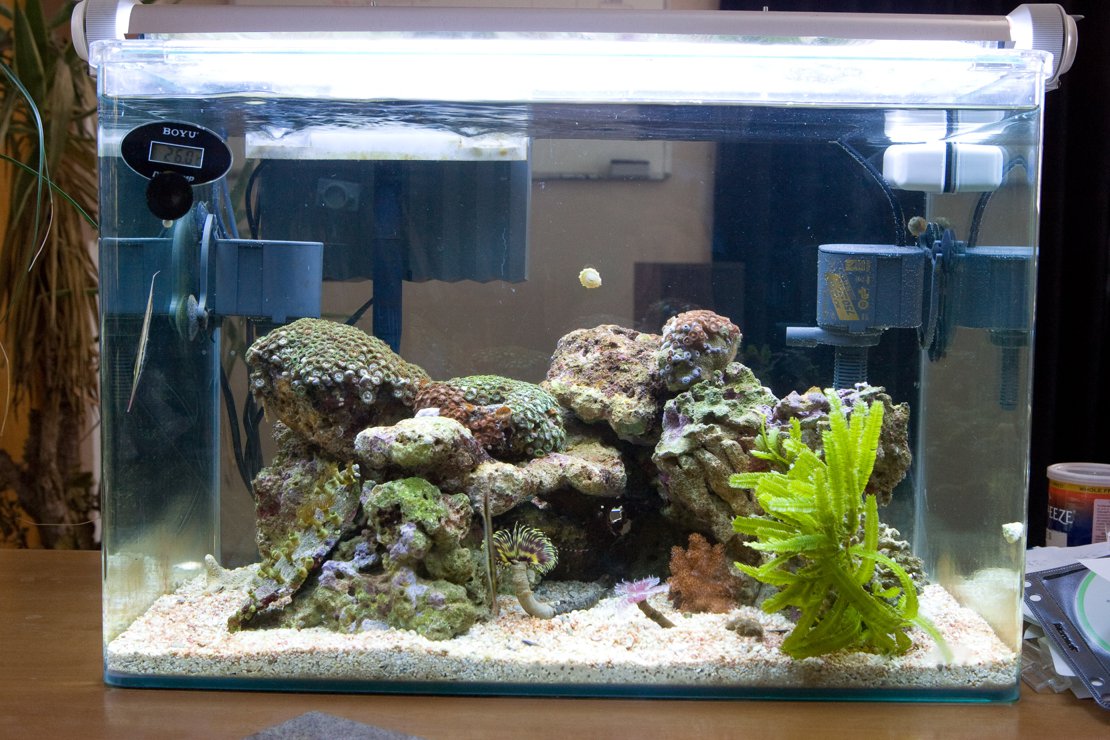
After I completed the 480g tank I tore down the 125g as it is just too expensive and much effort to maintain 3 full blown tanks. I did however always played with the idea of a small nano tank in my office. The content would be Zoanthids, mushrooms, some inverts and some delicate fish like Seahorses and pipefish.
I had some major prerequisites however.
- The tank must not be expensive. I just finished most of the expenses on my 480g tank and needed a break.
- The tank needed to be a low maintenance tank - I cannot afford maintaining three full blown aquariums.
- The tank must be quiet
- It must operate without complicated automated equipment
- It must not have a sump (space issue)
So I started doing research (once again). I discovered many cool tanks but most were not available in the country. I was adamant to get a tank between 10 and 20g (38 - 76L) in size - nothing bigger. Eventually the closest one fitting the bill was an AquaH2O 15g rounded edge glass tank.
This tank has no overflow weir, but the top is much more open than the JBJ NanoCubes - which I did not like. Also, it has a flat front glass panel which makes photography much easier.
Note that keeping a nano tank is cheaper, but much more difficult than keeping a slightly bigger aquarium between 30g and 200g. The reasons for this is partly due to the small water volume making it difficult to maintain stable water parameters, as well as the limited dilution capability for nutrients, food, additives - hence your margin for error is much smaller.
This article will discuss how I ended up with this tank.
Tank
As I said before, the tank is an AquaH2O 15g Glass aquarium measuring 50cm wide x 33cm deep x 34cm high. It has two rounded corners and a glass top that fits loosely on plastic brackets. With the tank a 24W PC light fitting is bundled, as well as an AquaH2O HOB filter and a 50W heater.
I discarded all those equipment as they are really not up to the quality I am used to. Lateron I will discuss the replacement components.
The substrate is 8kg crushed coral, and I have about 7kg Fuji live rock in there. I got the live rock fully cured from an LFS that had them in the display tanks. So they also had lots of pods and other microfauna.
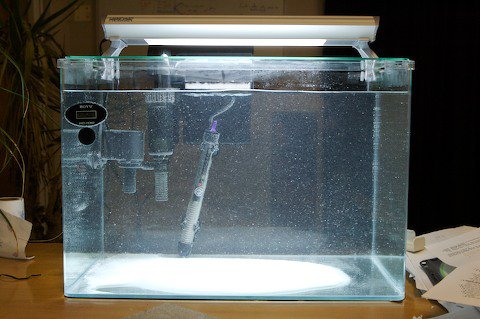
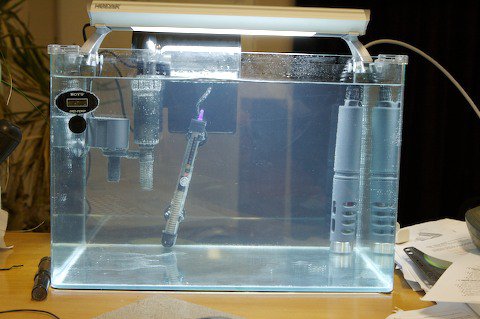
Top left is the tank after I added RO water and threw in the salt. The MaxiJet 750 pump mixed the water. Top right the salt had dissolved, a couple of hours later.
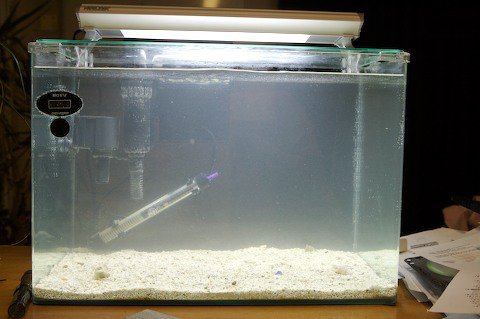
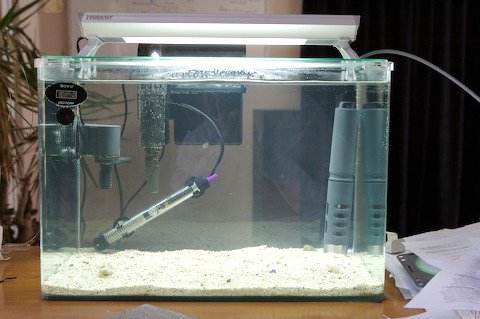
Top left I added the pre-washed crushed coral sand, which obviously clouded the water. To the right the tank is clear again after running like that through the night.
The tank itself rests on top of a thick sheet of plastic - much like polystyrene, but just 1mm thick. This is fine as there is only 45kg of water in the tank.
Lights
As I mentioned earlier, the tank came with a 24W PL fluorescent tube and fixture. I was positive however that the Kelvin rating of the tube was for planted freshwater aquaria, and not suitable to marine organisms. That, together with the fact that it did not produce enough light prompted me to replace it with a 2 x 24W T5 AquaBlue+ light fixture. This light fixture currently rests on top of the aquarium. I will eventually build it in to a nice canopy.
The increase in light is dramatic and also at the right temperature - 11000K.
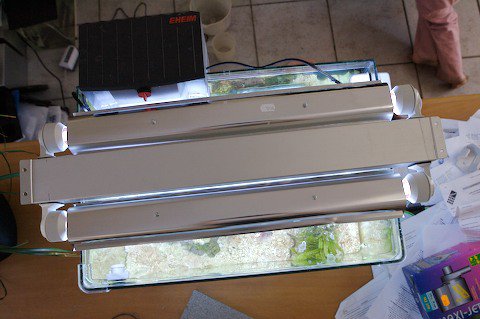
Mechanical Filtration
Since this tank does not have a sump, I replaced the AquaH2O HOB filter with an Eheim Liberty 200 HOB. The idea was that much of the success of this tank will depend on how well I can introduce surface agitation, and how well I can filter out particles suspended in the water column. The Eheim has several sponge strips that provides an area for nitrifying bacteria to colonise as well as removing particles from the water column. The water is drawn from far below the surface and delivered back to the aquarium at a rate of roughly 750L/h. Because it uses an Eheim pump it is much more reliable than the previous HOB filter.
Chemical Filtration
I have not bothered with this... Will see whether it becomes necessary.
Biological Filtration
I have no place for a skimmer, and decided not to use one based on many opinions that adding a skimmer to a nano reef will do more harm than good. The only biological filtration I currently have are the sponges in the HOB filter, the 7kg LR and the 2cm substrate. Nano reefs depend on regular water changes to export nutrients before they start polluting the water. Furthermore, ideally one never overstock a nano.
Heating/Cooling
To heat the aquarium I added a 100W Jager heater and uses it's internal thermostat for regulating the temperature. I have no chiller since the tank is located in my office which is air conditioned.
Additives/Topup
Since I did not want to clutter the tank with equipment I currently have no automated topup system. It evaporates at a rate of about 1L per 4 days, so this is not a big issue. I manually add RO water as needed. No other additives are added as all the elements are being replenished by the regular water changes.
Flow
This is a very delicate issue. Too much flow and the idea of pipefish, shrimpfish and seahorses goes out of the door. Too little flow and the coral would suffocate and cynobacteria might take over. So I installed two MaxiJet MJ750 pumps - each capable of 670 L/h. Since I did not want to have stagnant flow patterns, I improvised a clever trick to use one timer and have them switch on alternatively. They are located at opposite ends of the tank, pointing towards the back glass panel in order to "smear out" the flow over a broader area. One timer has 8 programs, each 1 hour 30 minutes in duration. When the timer is on, the left pump operates and the right pump is turned off. Then the timer turns off, the right pump operates and the left one shuts down.
The HOB filter itself produces about 750L/h of flow, so at any given moment I have at least 31 times the tank's volume of turnover per hour. All this and the flow is still gentle enough for the fish.
To connect the two pumps, all you need is one timer and a DPDT 220V Relay. The relay is used to negate the logic of the timer for the other pump.
Automation
Except for the timer to turn on the lights at 09:00 an turn them off at 22:00, and the timer/relay for the powerheads there is no automation. I wanted to keep this cheap and simple.
Water Parameters
Parameters are checked with the same test kits as the 145g reef. Parameters I keep this aquarium at are:
| Parameter | Value |
|---|---|
| pH | 8.40 |
| Temperature | 26.7 C |
| Specific Gravity | 1.0235 |
| Ammonia - NH3 | 0 mg/L |
| Nitrite - NO2- | 0 mg/L |
| Nitrate - NO3- | 1 mg/L |
| Calcium - Ca | 480 mg/L |
| Alkalinity | 5 dKH |
| Phosphate - PO | 0.045 mg/L |
| Magnesium - Mg | 1280 mg/L |
Feeding
Since the water volume is so small, I feed my pipefish and razorfish newly hatched brine shrimp as well as cyclopeeze daily.
Maintenance
Once every third day I'll add 1L of RO water as topup. Once every two weeks I do a 20% water change with RO/DI water mixed to the correct specific gravity using Tropic Marine Pro Reef salt. I scrape the algae off the glass as required, and blow off detritus and algae from the live rock as required. Once a month I clean out the HOB sponges by rinsing them in old saltwater.
Water parameters are checked once every week until I am satisfied the system has stabilised, after which I'll do it once a month.
Backup
Since the tank is located in my office everything is connected to my 3000VA Online UPS which would be able to keep everything running - including my computers - for at least 8 hours.